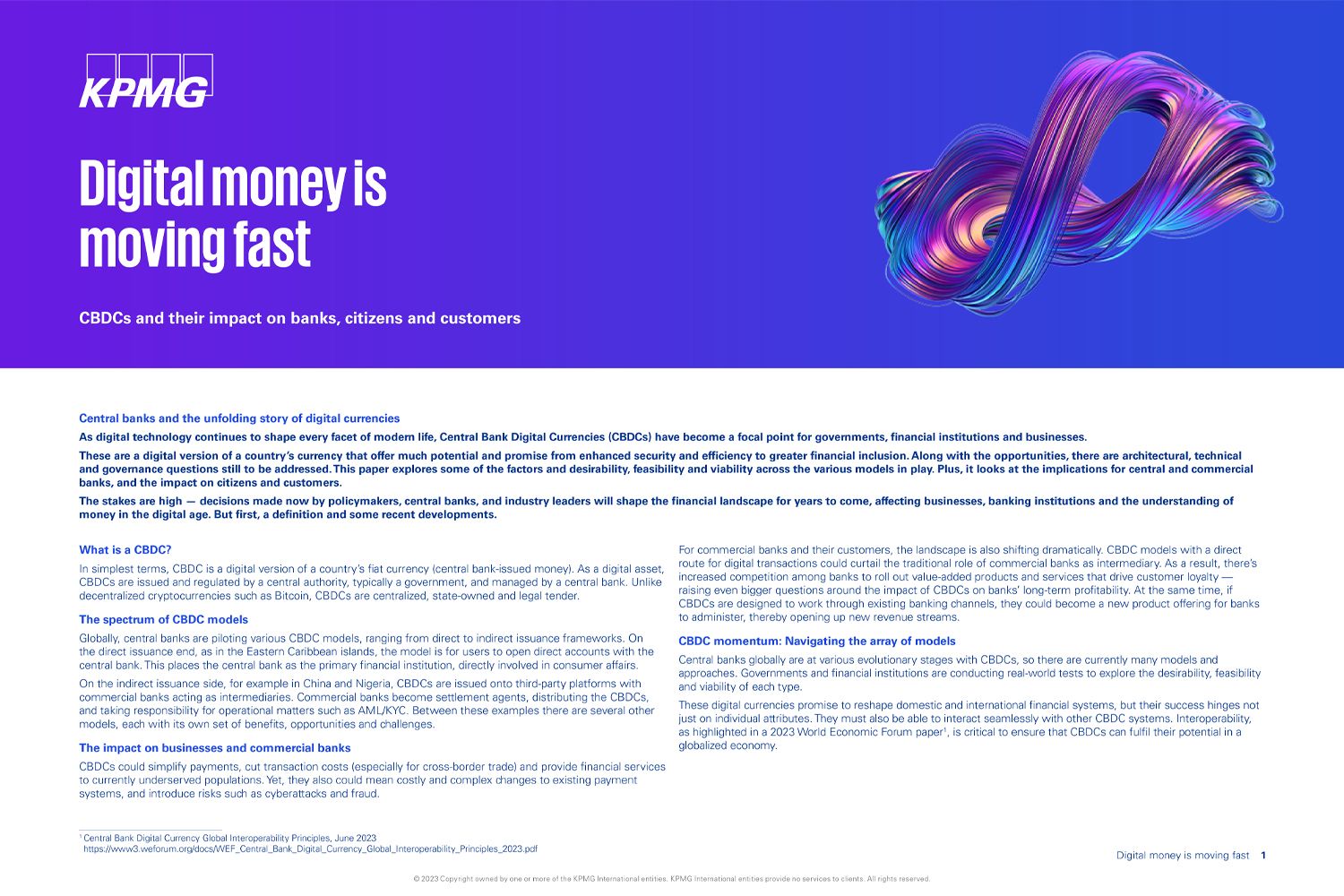In a digital age where technology influences every aspect of our lives, Central Bank Digital Currencies (CBDCs) have emerged as a significant focus for governments, financial institutions, and businesses. These digital versions of national currencies promise enhanced security, efficiency, and increased financial inclusion. However, they also raise questions regarding architecture, technology, and governance. Download the PDF for an in-depth exploration of the various CBDC models and their implications for central and commercial banks, as well as citizens and customers.
What is a CBDC?
A CBDC is a government-issued digital version of a country's fiat currency, regulated by a central authority, and managed by a central bank. Unlike decentralized cryptocurrencies like Bitcoin, CBDCs are centralized, state-owned, and recognized as legal tender.
Impact on businesses and commercial banks
CBDCs can simplify payments and reduce transaction costs but may also introduce complexities and risks. Commercial banks face competition and opportunities for value-added services, while potentially seeing changes in their traditional roles.
CBDC models
Central banks globally are at various evolutionary stages with CBDCs, so there are currently many models and approaches. Governments and financial institutions are conducting real-world tests to explore the desirability, feasibility and viability of each type.
These digital currencies promise to reshape domestic and international financial systems, but their success hinges not just on individual attributes. They must also be able to interact seamlessly with other CBDC systems. Interoperability, as highlighted in a 2023 World Economic Forum paper[i], is critical to ensure that CBDCs can fulfil their potential in a globalized economy.
Main CBDC models follow the four following archetypes:
Wholesale CBDC for domestic use
Focusing first on Wholesale CBDCs aimed at domestic financial institutions, these have significant potential to revolutionize domestic payment systems and interbank settlements. While they are feasible and advantageous for these specific sectors, it's worth noting that their scope and impact are confined to a specialized market within the financial industry.
Retail CBDC for domestic use
Turning to Retail CBDCs, which are intended for the general public, these offer notable benefits from a consumer standpoint. However, their introduction poses considerable challenges in terms of feasibility. Specifically, there are concerns about how these might disrupt existing commercial banking systems and potentially destabilize financial markets.
Retail CBDC for cross-border use
Using Retail CBDCs for cross-border transactions offers advantages, but these are largely theoretical at this stage. While they could offer benefits to individual consumers engaging in international trade, several obstacles stand in the way, such as foreign exchange management, consumer protection and regulatory compliance.
Wholesale CBDC for cross-border use
Finally, of the various options, Wholesale Cross-Border CBDCs are emerging as the most balanced in terms of desirability, viability and feasibility. These digital currencies hold promise for significantly streamlining international trade by eliminating inefficiencies in traditional banking systems, allowing multiple currencies and assets to be settled and various access policies to coexist.
As central banks worldwide explore various CBDC models, Wholesale Cross-Border CBDCs have emerged as a top priority for many, due to their desirability, viability and feasibility. This shift marks a transition from years of theoretical study to the actual process of productization. Before diving into the critical questions central banks must consider, let's first outline the broader opportunities and risks of adopting CBDCs.
Opportunities and risks of CBDCs
CBDCs offer efficient payments, cost savings for central banks, and financial inclusion. However, they require acceptance, address regulatory challenges, and demand robust security measures.
Five crucial questions for central banks
1. What is our adoption strategy?
Central banks need to carefully consider their adoption strategy for CBDCs as compared to traditional money. This involves examining the current payment landscape and planning how it will accommodate CBDCs. Setting realistic goals based on detailed business cases can help guide design and policy decisions.
2. What is our role and who do we serve?
It’s essential to clarify the level of central bank involvement and the roles that commercial banks and other financial institutions will play in the CBDC ecosystem. Assumptions shouldn’t be made that all businesses will automatically act as distributors. The CBDC’s design should also meet the specific needs of various users, whether they’re private citizens, commercial banks or corporations.
3. What happens if there’s a run on CBDCs?
Because CBDCs can be remunerated, they offer advantages but also pose risks, such as potential runs on commercial bank deposits during a crisis. Design features like individual holding limits and tiered remuneration need to be considered to maintain financial stability.
4. How good is our cybersecurity?
The security and resilience of the CBDC infrastructure is paramount to prevent potential cyberattacks and technical glitches, which could disrupt national and international financial systems. Robust security measures and protocols are crucial for mitigating these risks.
5. What are our resource and capability requirements?
Managing CBDCs will likely demand significant resources and capabilities, even from well-governed central banks. New decision-making processes, change management practices, and partnerships will likely be needed for effective CBDC implementation.
Five business-critical questions for commercial banks
1. How will we ensure interoperability?
Commercial banks can be partially responsible for the technical infrastructure that supports CBDCs, so it's crucial that their systems are designed to be interoperable with digital currencies. This can facilitate the seamless movement of funds within the evolving payment landscape.
2. What infrastructure investment do we need?
Implementing CBDCs may require significant changes to core operations, affecting retail banks, payment service providers and merchants alike. While modernizing their payment processes, these organizations should also continue to maintain their existing operations.
3. How could our liquidity and capital requirements be impacted?
Maintaining adequate liquidity and capital buffers is essential when implementing CBDCs. Advance planning is needed to help ensure that continuous risk assessment is in place, along with the ability to anticipate any policy changes.
4. Is anti-money laundering (AML) compliance assured?
CBDCs need to be integrated into banks' existing AML frameworks. This will likely require adapting or developing new AML controls and monitoring processes to stay compliant with regulations.
5. Is disruption likely?
The introduction of a retail CBDC could see central banks becoming competitors in the payments industry. This has the potential to destabilize funding bases for commercial banks. Furthermore, the introduction of new risk-free assets could disrupt capital markets. Careful design choices are especially important for retail CBDCs to mitigate these risks.
Supporting CBDC development
CBDCs are reshaping the financial landscape, offering opportunities and challenges for central and commercial banks. Careful planning, analysis, and professional guidance are important to navigate this evolving digital currency landscape.
KPMG professional can offer strategic vision, use case identification, infrastructure readiness, system security, capability building, and guidance on system convergence and interoperability to assist in successful CBDC implementation, contact us for a discussion.
Our insights
Why work with KPMG in Thailand
KPMG in Thailand, with more than 2,000 professionals offering Audit and Assurance, Legal, Tax, and Advisory services, is a member firm of the KPMG global organization of independent member firms affiliated with KPMG International Limited, a private English company limited by guarantee.







